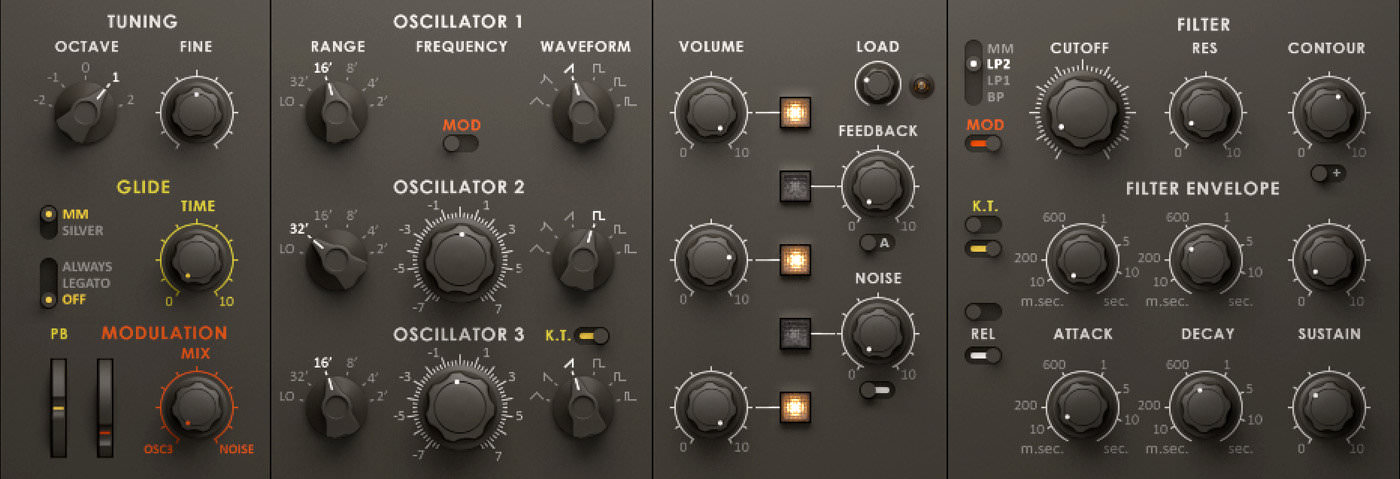
u-he are makers of award-winning software synthesisers and effects including Diva, Repro-1, Zebra2, Hive, Bazille, Presswerk and Satin.
Visit U-he

u-he are makers of award-winning software synthesisers and effects including Diva, Repro-1, Zebra2, Hive, Bazille, Presswerk and Satin.
Visit U-heSynth Secrets is a series of programming tutorials in which we show how to make a range of classic and new synth sounds using plugins such as Massive, Sylenth and Diva.
For this instalment of Synth Secrets we’re going to pick up where we left off the other week, looking at processing our synth sounds using Eventide’s powerful Anthology X plugin suite.
We’ll begin with this monophonic synth sound:
And using the Eventide Octavox Harmonizer we’ll create this much more complex part:
Here’s the MIDI we’ve used for this synth loop, a simple hook in the key of B Minor:
For this walkthrough we’ll be using Native Instruments’ Monark synth. Monark is a faithful Minimoog emulation, and thus is a monophonic synthesiser and a great example of when a technique like this is very effective.
We begin by loading the Monark ensemble within an instance of Reaktor 5 (Monark being a Reaktor instrument). We load the ‘010 Half Life’ preset from the ‘001 Bass’ list of Bass presets, then tweak the sscillator section slightly, taking Oscillator 1 up an octave by setting the Range control to 32’. We take the Range of Oscillator 2 down to 32’, and we set the Frequency of Oscillatorand 2 and 3 to 0, though slightly detuned.
We turn the volume of Oscillator 2 up, and on the Filter Contour section we check the switch underneath the control, changing it from – to +, reversing the filter modulation.
We now have a warm, analogue-sounding bass hook, with some detuning on the oscillators helping to thicken the sound.
With our sound set up, we can now use the Octavox Harmonizer pitch-shit effect to take things to a completely different level. If you are familiar with Ableton’s Chord MIDI effect or Logic’s Chord Trigger, Octavox works in a similar way but in audio, adding extra voices that can be pitched to musical intervals.
One big advantage of using Octavox is that we have more control over aspects of each individual voice, such as level and pan controls, and we also have the option to add a delay to individual voices.
To proceed, we load an instance of Octavox on our synth channel. With the default patch that loads up we’re instantly in melodic techno territory:
Head to the patch browser menu and select the ‘Default’ patch at the bottom to reset Octavox. This will leave us with just one voice activated. It’s important at this stage to set the key of Octavox so that the extra voices we add play in the same scale as our original synth hook. We can do this in the section to the right of the Notation Grid, setting our key to B and our scale to Natural Min (as per our synth hook).
We can hear that we’ve lost a bit of volume now as the effect is 100% wet. In the bottom left corner of Octavox, dial down the Mix control to 42% to bring back in the dry signal.
Now let’s look at our first voice. Let’s take the Level control all the way up to 0.0 dB, and in the Pitch column click up in the Interval box. Play back the sequence whilst you do this to hear the vibe different intervals bring. We keep clicking up until we get to +10th – this is adding an extra voice a 10th (15 semitones) above our hook.
Now we add two more voices. You can turn them on by clicking on the power button in the Active column.
We take the Level of Voice 2 down to -9.7 dB and pan it to the right slightly. We take the interval up to +2 oct and also detune the voice in the Cents column, taking it to -17.4 cents.
For Voice 3, we take the level down to around the same setting as Voice 2, but this time we pan it to the left slightly. Take the Interval to +2 oct and push up the Cents parameter to 8.0. This adds a very bright harmonic to the synth, slightly detuned for extra warmth, with the panning adding some nice width in the high frequencies.
Now we can get busy automating both parameters on the synth and engaging the delay section of Octavox for some really cool sound design. First we increase the feedback of the delay on Voice 2 to 61.5%, and to 47.4% for Voice 3. Now we set up automation lanes for the delay times of both Voice 2 and Voice 3, increasing the delay times to 192.0 ms as the phrase reaches the end of the 4-bar sequence.
To emphasise this effect we also take down the cutoff of Monark to about quarter of the way round, and pull down the Amp Decay setting to about a quarter of the way too.
Finally, we add in some automation on the Amp Decay and Cutoff parameters in Monark, and add a reverb on a bus send courtesy of Valhalla’s VintageVerb.
You can load Octavox on any audio source, so be sure to experiment. It sounds great on vocals, of course, but also works a treat transforming simple melodies into something more complex, or even changing percussive hits into chord stabs.
26th February, 2016

u-he are makers of award-winning software synthesisers and effects including Diva, Repro-1, Zebra2, Hive, Bazille, Presswerk and Satin.
Download the demos and try them for yourself at www.u-he.com
Attack Magazine is funded by advertising revenue. To help support our original content, please consider whitelisting Attack in your ad blocker software.
x